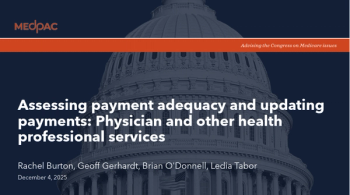
- May 25, 2018 edition
- Volume 96
- Issue 09
Is it time to lift the ban on physician-owned hospitals?
Physician-owned hospitals have strengths that are especially relevant during an age of value-based care and comparison healthcare shopping
Physician-owned hospitals have strengths that are especially relevant during an age of value-based care and comparison healthcare shopping. In particular, these facilities-essentially banned since 2010-tout superior patient experience and higher quality at a lower cost than competitors.
Unlike their nonprofit or academic counterparts, physician-owned hospitals are funded at least partially by physician owners (e.g., 50 percent physician-owned) who receive a bonus based on the facility’s profitability. Physician investors, especially primary care physicians, don’t necessarily see patients in the hospital at all, but may refer patients seen in their office. They are deeply involved in the administration of the hospitals in which they invest-a factor proponents say enhances physician owners’ commitment to promoting excellent patient care.
And these facilities may be making a comeback. In early 2018, within weeks of assuming his role, Health and Human Services Secretary Alex Azar publicly stated an interest in relaxing the moratorium put in place as part of the Affordable Care Act (ACA).
Such a decision could have vast implications for primary care physicians and their patients.
Cost comparisons
A key reason that physicians-owners and non-owners alike-refer patients to physician-owned hospitals is that they can often offer tests and procedures at lower prices than neighboring community hospitals, says Ron Rock, CRNA, who served as chief executive officer of Northwest Specialty Hospital, a 21-bed surgical hospital in Post Falls, Idaho, from 2007 to 2011, and has been a continuous investor.
For example, while a total hip replacement would cost roughly $22,000 at Northwest Specialty Hospital, the same procedure with the same surgeon and same implant in a competing nonprofit hospital would cost $57,000, says Rock. “We have much lower overhead, but I honestly don’t know how they get away with charging more than double. I plain don’t know where the money goes.”
In addition to lower prices and greater cost transparency, Northwest and similar facilities throughout the country demonstrate high CMS ratings and below-average infection rates. Part of the reason that small surgical hospitals are able to keep pathogens at bay is the elective nature of most of the procedures they perform, with clear pre-surgical criteria for patients, notes Rock. Very complex patients or those at high risk for complications are typically referred to general hospitals equipped to manage emergencies if they arise.
A history of controversy
The foremost complaint about physician-owned hospitals is that physician owners’ ability to self-refer to these facilities results in cherry-picking of healthier and wealthier patients, opponents allege, leaving the majority of complex and indigent care to safety net hospitals.
The 2010 regulations prohibit new physician-owned hospitals from participating in Medicare or Medicaid, thereby cutting off a vital source of revenue to sustain the facilities. Physician-owned hospitals established before the ACA are grandfathered into receiving government reimbursement, but are permitted to expand only under limited circumstances. Hospitals that don’t qualify for exceptions may not add beds or new service lines or increase their percentage that is physician-owned.
Value-based goals
The mission of Northwest Specialty Hospital has been based on philosophies aligned with value-based goals since it opened in 2003, says Rock.
“We started with the idea that we could be very competitive pricewise and offer a better-quality product in terms of infection rate, turnaround, patient satisfaction, and physician satisfaction,” he says. “Those were our foundational goals, which carried us through the first few years.” The restrictions included in the ACA, however ironically, have made them harder to achieve, he says, not only by blocking expansion of the hospital, but by making it nearly impossible to recruit new physicians unless current ones depart.
Christopher Billingslea, DO, a primary care physician and part-owner of Northwest Specialty, disputes much of the criticism physician-owned hospitals have faced. “There’s no pressure from the specialty hospital to refer to its providers,” he adds. “If physician-owned hospitals became worse facilities or more expensive, I’d just stop referring to them. I’m something of a firm believer in competition.”
Like many non-proceduralists, Billingslea works solely out of his private practice, while area hospitals, including Northwest, employ a hospitalist model. Of the 31 physician-owners of Northwest Specialty Hospital, 15 are primary care providers, says Rock. “Of the primary care doctors who are owners, they still refer outside of our hospital, depending on what relationship they have with which specialist and what the patient’s needs are,” he says.
Most of the referrals to the hospital come from physicians with no financial incentive to do so, Rock says. He estimates that about 60 percent of referrals come from community-practice physicians who are not investors in Northwest.
Consequences of the status quo
A healthcare environment that hinders growth and success of physician-owned hospitals is detrimental in that it limits patient choice, according to advocates.
“Hospital consolidation hurts patients through lower quality, increased costs, and reduced access-essentially the opposite of the Triple Aim,” says John Richardson, executive director of Physician Hospitals of America (PHA), the trade group for physician-owned hospitals.
According to the PHA, 37 physician-owned hospitals were not built because of the ban, 40 nearly finished construction projects were prevented, and 20 major expansion projects were canceled.
Richardson also refutes the claim that physician-owned hospitals cherry-pick the most lucrative patients. “In fact, the only comprehensive peer-reviewed study [on the topic] concluded that physician-owned hospitals treat similar patient populations as our competitors.”
Ownership vs. specialization
The research, central to the PHA’s position, was conducted by Massachusetts General Hospital and Harvard and published in BMJ in 2015. The observational study used data from 2,186 U.S. acute care hospitals (219 physician-owned hospitals and 1,967 non-physician owned hospitals) from across 95 hospital referral regions in pre-ACA 2010, and concluded that although physician-owned hospitals may treat slightly healthier patients, they do not systematically avoid low-income patients or those from ethnic and racial minority groups.
Lead author Daniel M. Blumenthal, MD, MBA, attributes the results, in part, to a study sample more representative of the current ratio of specialty hospitals to general medicine physician-owned hospitals. “One of the main findings, and why I think this study is important, is that all previous studies of physician-owned hospitals focused on a subset of them,” Blumenthal says.
When physician-owned hospitals began to emerge, the vast majority of them were specialty hospitals, which typically contain fewer than 100 beds, have no emergency department (ED), and often focus on one surgical specialty, he explains. “If you look at the hospitals in our [2010] study, the majority are generally larger acute care hospitals with several hundred beds. They have big EDs. They look just like community hospitals.”
Although grouped together in most previous studies, the two subcategories of physician-owned hospitals operate under vastly different business models, he says. Overall, 80 percent of the patients treated at physician-owned hospitals today are seen at the general-medicine subtype, Blumenthal says. “They may treat as many Medicaid patients as 10 smaller specialty hospitals. It’s like comparing apples and oranges.”
The research from Blumenthal and his team was not available in time to inform the restrictions included in ACA. “Policymakers might consider taking into account the fact that physician-owned general hospitals and physician-owned specialty hospitals may have very different impacts on spending patterns and on surrounding hospitals that they compete with,” he says. “The selection of patients may be very different between those hospitals because their operating models are very different.”
For instance, a large general hospital (physician-owned or not) needs to have an ED, both because it has a bigger community presence and in order to fill beds. “And once you create an ED and you open yourself up to the community, you completely lose control over who you take care of. And once you’re a general hospital, you need all of the other services that a specialty hospital doesn’t provide to everybody,” Blumenthal says.
Nonetheless, under current law, all physician-owned hospitals, regardless of size or scope, are subject to the same rules governing self-referral.
What is a ‘whole hospital’?
Self-referral to hospitals is currently permitted under the “whole hospital” exemption included in the Stark law. This exemption requires that the referring physician owner have a financial interest in the whole hospital, and not just a specific part, such as one service line or department. In addition, he or she must be authorized to perform services at the hospital and be expected to actually perform the services.
The 2010 restrictions were put in place to curb abuse of the exemption, says Jeff Cohen, executive vice president of public affairs for the Federation of American Hospitals (FAH). “What policymakers had to grapple with was that [physicians] were getting around the law,” he says.
They did this, he contends, by opening up five- to 15-bed facilities with no ED, obstetrics, trauma, mental health, or general-medicine services and calling them “whole hospitals.”
The ACA effectively closed this loophole, Cohen says, but not without challengers. H.R. 1156/S. 1133, the Patient Access to Higher Quality Health Care Act of 2017, for example, proposed repeal of the current law limiting self-referral to physician-owned hospitals.
In response, the FAH and American Hospital Association (AHA) co-authored a letter urging Congress to oppose the bill. “The law as it stands protects patients, businesses and taxpayers. It also helps ensure that community hospitals can continue to meet their mission to provide quality care to all the patients in their communities,” they wrote.
The FAH and AHA also dispute the findings of Blumenthal’s study, citing a whitepaper written by healthcare economics consulting firm Dobson DaVanzo. “The analysis compares the performance of non-physician owned full-service community hospitals with physician-owned hospitals,” they wrote. “The characteristics of these PHA hospitals virtually mirror the findings and data collected in the early-to-mid 2000s that drove Congress to enact the law prospectively banning self-referral to new facilities.”
Opportunities either way
Cohen emphasizes that neither he nor the FAH oppose exceptions to the ban that allow physician-owned hospitals to expand. For example, physician-owned hospitals that take as much Medicaid as other hospitals in the county or prove community need qualify for an exception.
“What has been found is that in several instances where you have hospitals that have adapted, the physicians are happy and the community is happy,” Cohen says. “There is a way folks who want to be able to grow or build on their footprint can do so. All they have to do is take all comers.”
On the other hand, Blumenthal notes that specialty hospitals with a limited array of services aren’t inherently problematic. He cites an example of two healthy patients who both need a knee replacement and are seeing a doctor who owns an orthopedic hospital-but one patient has commercial insurance and the other is covered by Medicaid.
“They should both get referred to the specialty hospital,” says Blumenthal. “However, if the Medicaid patient gets referred to a community hospital and the commercial patient gets referred to a specialty hospital, that’s a huge problem that should not be allowed to stand.”
Articles in this issue
over 7 years ago
New codes for collaborative careover 7 years ago
The pros and cons of hiring family members as practice employeesover 7 years ago
Protect the practiceover 7 years ago
5 key factors in considering MACRA virtual groupsover 7 years ago
Mitigate security risks for medical devicesNewsletter
Stay informed and empowered with Medical Economics enewsletter, delivering expert insights, financial strategies, practice management tips and technology trends — tailored for today’s physicians.














